 Menu
Menu
|
School University (1), Castelvì (2) |

| ||
|
Function To study the characteristics of the capacitors. | |||
|
|||
|
Description It is a condenser formed by a metallic glass with another glass inside containing another conic metallic conductor with a knob in the upper part. | |||
|
School University (1), Spano (2) |

|
||
|
Function To study the connections between capacitors. | |||
|
|||
|
Description The four separately removable jars are contained in a case of shining wood with four sections and with a metallic bottom. The metallic bottom is connected to a hook. The inner armatures are connected in parallel by four conductors connected with screws, so as to allow the use of every capacitor separately. | |||
|
School Spano |
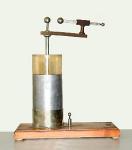
|
||
|
Function It is used to measure the electricity supplied to a capacitor. | |||
|
|||
|
Description Leyden jar of 231 cm, with a spark gap with a millimetre graduated scale and a vernier. The support of the spark gap is made of ebonite and it is attached to the conductor or the inner armature of the jar. | |||
|
School Spano |
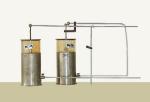
|
||
|
Function To show the electric resonance. | |||
|
|||
|
Description The two jars have the outer armatures made of a nickered brass sheet, with connections for the lateral conductor of resonance. The first rectangular circuit, made of a thick aluminium wire, includes the first Leyden jar and the spark gap movable by hand with its ebonite support. The second circuit is formed by the second jar and by two parallel aluminium wires supported by an ebonite support. Against the latter and perpendicularly to it, there is a third conductor movable by an ebonite handle. If the conditions for the oscillating discharge are satisfied, we obtain a close oscillator and a close receiver, that can become tuned by shifting the mobile conductor. In that case, the discharge in the adjustable spark gap placed on the armature of the second capacitor, will correspond to the discharge of the first capacitor. | |||
|
School Castelvì (1), Spano (2) |
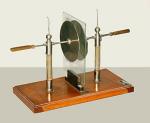
|
||
|
Function To study the characteristics of a plate capacitor. | |||
|
|||
|
Description This is the classic capacitor, with two metallic sliding plates supported by insulating columns, separated by a painted glass sheet. The small pendulums indicate the presence and the quality of the electric charge. | |||
 Menu
Menu
|
School University |
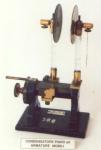
|
||
|
Function To study the characteristics of a plate capacitor. | |||
|
|||
|
Description It is a model of Epino’s capacitor, with two metallic plates supported by insulated columns sliding on the basis with the possibility of millimetric variations. In this way it is possible to change the distance between the armatures and to change the capacity of the capacitor. | |||
 Menu
Menu
|
School University |

|
||
|
Function Accessories for electroscopes and for Volta’s electrophorus. | |||
|
|||
|
Description Cooper and zinc plates with an insulating handle. | |||
 Menu
Menu
|
School University (1), Spano (2), Pellegrini (3) |
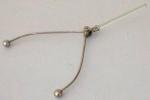 (2) (2)
|
||
|
Function It is used to discharge the Leyden jars. | |||
|
|||
|
Description (2) The two dischargers, ending with two spheres, are hinged and independent one from the other on a single glass handle. A set screw in the hinge allows to fix the position of the two arcs in a stable manner. | |||